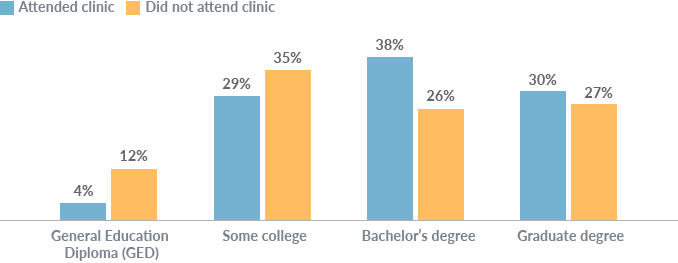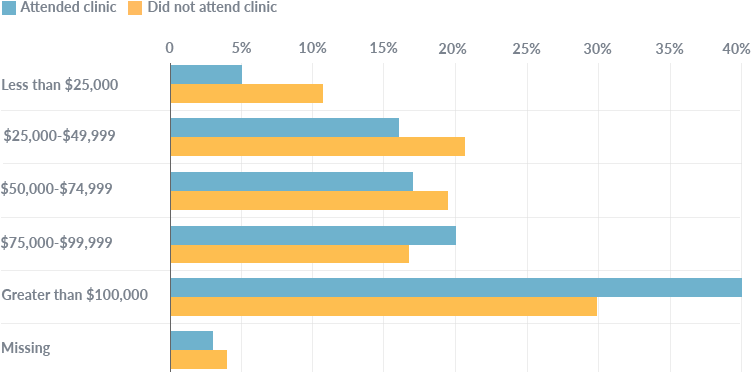Research Summary
Attendance at Fragile X Specialty Clinics: Facilitators and Barriers
Date Published: May 2019
What was the research about?
Access to health services is important for everyone, but especially those with intellectual and developmental disabilities. However, research shows that individuals from underrepresented groups, such as racial and ethnic minorities or those with lower incomes, may have a harder time getting health services. The Fragile X Clinical and Research Consortium is a group of specialty clinics across the United States that aims to provide medical care and specialized services, such as genetic counseling and therapy, to people with fragile X and their families. In this study, we wanted to learn more about who attends fragile X clinics. We also wanted to understand what factors might affect people’s ability to attend fragile X clinics. We thought that things like parents’ awareness of clinic services and parents’ relationship with their child’s primary care provider could affect fragile X clinic attendance.
What did the research team do?
We looked at information from four sources:
- A survey of families who are part of Our Fragile X World (OFXW) research registry
- A survey of parents in the Community Support Network (CSN), which is made up of local support groups for families of children affected by fragile X
- Demographic information about children and their families who attended fragile X clinics as part of the FORWARD project, a multi-site study funded by the Centers for Disease Control and Prevention (CDC)
- Demographic information about families who are part of the Fragile X Research Registry (FXRR), which is co-hosted by the University of North Carolina at Chapel Hill and the University of Wisconsin at Madison
Who was in the study?
We surveyed 457 parents through OFXW and 318 parents through the CSN. We also looked at demographic information from 450 parents from the FORWARD Project and 434 parents from the FXRR.
Here, we will mostly report what we learned from looking at the information from the OFXW and CSN surveys.
What did the research team learn?
There were differences between families who attended fragile X clinics and those who did not.
OFXW families were more likely to visit a fragile X clinic if their child with fragile X was 18 years old or younger.
Figure 1. Attendance at fragile X clinics by OFXW families

19 years
average age of people with fragile X who attended clinic
23 years
average age of people with fragile X who did not attend clinic
Children who were more severely affected by fragile X, measured by the number of co-occurring conditions they had (e.g., autism, seizures), were also more likely to have visited a fragile X clinic.
Figure 2. Co-occurring conditions of people who attended/did not attend clinic

Source: Our Fragile X World
| Attended clinic | Did not attend clinic | |
|---|---|---|
| Less than 5 co-occurring conditions | 48% | 60% |
| More than 5 co-occurring conditions | 52% | 40% |
Parents who had higher education levels and higher household incomes were more likely to bring their child to a fragile X clinic than families with lower education levels and lower household incomes.
Figure 3. Education level of parents whose child did/did not attend clinic

Note: Percentages do not total to 100% due to rounding.
Source: Our Fragile X World
| Attended clinic | Did not attend clinic | |
|---|---|---|
| General Education Diploma (GED) | 4% | 12% |
| Some college | 29% | 35% |
| Bachelor's degree | 38% | 26% |
| Graduate degree | 30% | 27% |
Figure 4. Annual household income of parents whose child did/did not attend clinic

Note: Percentages do not total to 100% due to rounding.
Source: Our Fragile X World
| Attended clinic | Did not attend clinic | |
|---|---|---|
| Less than $25,000 | 5% | 11% |
| $25,000-$49,999 | 17% | 21% |
| $50,000-$74,999 | 16% | 19% |
| $75,000-$99,999 | 20% | 16% |
| Greater than $100,000 | 40% | 30% |
| Missing | 3% | 4% |
There were also some ways in which families who attended clinics were similar to those who did not. For example, both groups were made up of similar percentages of:
- males and females with fragile X
- people from each race/ethnicity, with the majority of people with fragile X in both groups being white non-Hispanic
Similar patterns were found for families who responded to the CSN survey or were part of the FORWARD study or FXRR.
Parents' relationship with their child's primary care provider was not related to clinic attendance
OFXW parents answered questions about their relationship with their child’s primary care provider (PCP), including:
- How knowledgeable is your child's PCP about fragile X?
- How often does your child's PCP explain things so that you can understand?
- How often does your child's PCP involve you in making decisions?
- How often does your child's PCP respect your choices?
We found that parents' relationship with their child's PCP did not affect whether their child attended fragile X clinic.
Parents' awareness of clinic services and their views about clinic visits were related to clinic attendance.
Parents who took the CSN survey were asked how much they agreed with statements about fragile X clinics, including whether:
- A general visit to a fragile X clinic was important.
- They were aware of services that the fragile X clinic provides.
- They knew about fragile X and could explain it to their child’s PCP.
Parents who thought clinic visits were important and were aware of services that the clinics provide were more likely to have a child who had attended a clinic. Parents who knew about fragile X and were able to explain it to their child’s primary care provider were also more likely to have a child who had attended a clinic.
What does this mean for families?
It is important for parents and their children with fragile X to be able to take advantage of the services provided by fragile X clinics. Unfortunately, some families may face barriers to attending fragile X clinics. But there may be ways to help families overcome these barriers. Advocates for people with fragile X may be able to increase clinic attendance by spreading the word about services that the clinics offer. Other ways to make clinics available to more people may include scholarships for people with financial barriers and telehealth appointments for people who cannot travel to the clinics.
Related resources
Visit the National Fragile X Foundation to find out more about the Fragile X Clinical & Research Consortium, including:
- The Fragile X Clinic: What Does It Mean For You?
- Planning Your Fragile X Clinic Visit
- International Family Support Network and Clinics
Read the full article by Dr. Kidd and colleagues
Source. Kidd, S. A., Raspa, M., Clark, R., Usrey-Roos, H., Wheeler, A. C., Liu, J. A., ... & Sherman, S. L. (2017). Attendance at Fragile X Specialty Clinics: Facilitators and Barriers. American Journal on Intellectual and Developmental Disabilities, 122(6), 457-475.